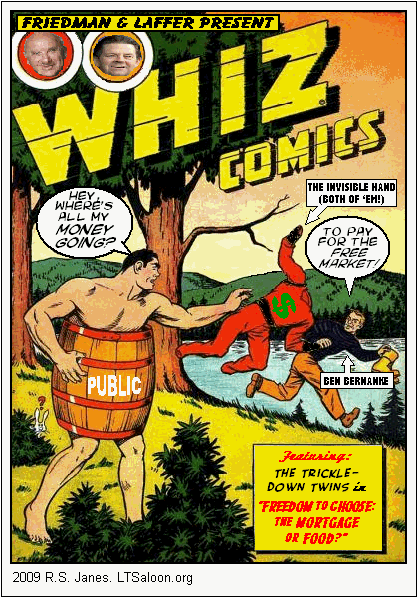
 Victor Lustig: the Man who sold the Eiffel Tower
Victor Lustig: the Man who sold the Eiffel Tower

Known as "the man who sold the Eiffel Tower",
Victor Lustig was one of the most talented confidence tricksters who ever lived. Born in 1890 in Bohemia, Czechoslovakia, he was a glib and charming conman, fluent in multiple languages. He established himself by working scams on the ocean liners steaming between Paris and New York City. Lustig's first con involved a "money-printing machine". He would demonstrate the capability of the small box to clients, all the while lamenting that it took the device six hours to copy a $100 bill. The client, sensing huge profits, would buy the machines for a high price, usually over $30,000. Over the next twelve hours, the machine would produce two more $100 bills. After that, it produced only blank paper, as its supply of $100 bills became exhausted. By the time the clients realized that they had been scammed, Lustig was long gone.
In 1925, Lustig's master con began when he was reading a newspaper: an article discussed the problems the city was having maintaining the Eiffel Tower. So he adopted the persona of a government official, and sent six scrap metal dealers an invitation to discuss a possible business deal. Lustig told the group that the upkeep on the Eiffel Tower was so outrageous that the city could not maintain it any longer, and wanted to sell it for scrap. So he sold the Eiffel Tower to one of the scrap metal dealers and took a train to Vienna with the suitcase full of cash. The buyer was too humiliated to complain to the police.
Later, Lustig convinced gangster Al Capone to invest $40,000 in a stock deal. Lustig kept Capone's money in a safe deposit box for two months, then returned it to him, claiming that the deal had fallen through. Impressed with Lustig's integrity, Capone gave him $5,000. It was, of course, all that Lustig was after.
On 1907, Lustig arrived to the United States and conducted a number of scams, but eventually his luck ran out: he was arrested for counterfeiting and sent to Alcatraz prison. On March 9, 1947, he contracted pneumonia and died two days later.
 Frank Abagnale: catch me if you can
Frank Abagnale: catch me if you can

The movie "Catch Me If You Can" is loosely based on
Frank Abagnale's exploits, as he collected over $2,5 million in 26 countries. Born in 1948, his first con was writing checks on his own overdrawn account. Then he printed out his own, almost perfect copies of checks. He also collected over US$40,000 by printing his account number on blank bank deposit slips and added them to the stack of real blank slips in the bank.
Then, for a period of two years, Abagnale masqueraded as Pan Am pilot "Frank Williams", to get free rides around the world by dead heading on scheduled airline flights. Later, he impersonated a pediatrician for 11 months in a Georgia hospital under the name "Frank Williams". He also forged a Harvard University Law diploma, passed the bar exam of Louisiana and got a job at the office of the State Attorney General of Louisiana.
Eventually he was caught in France in 1969 when an Air France attendant recognized his face from a wanted poster. When the French police apprehended him, 12 of the countries in which he had committed fraud wanted to extradite him. After a two day trial, he first served prison time in Perpignan's House of Arrest in France; a one-year sentence that was reduced by the presiding judge at his trial to six months. His stay in Perpignan left him fearful of spending more time in another version of the prison. He was then extradited to Sweden where he was treated fairly well under Swedish law. During trial for forgery, his defense attorney almost had his case dismissed by arguing that he had "created" the fake checks and not forged them, but his charges were instead reduced to swindling and fraud. He served six months in a Malmö prison, only to learn at the end of it he would be tried next in Italy. Later, a Swedish judge asked a U.S. State Department official to revoke his passport. Without a valid passport Swedish authorities were forced to deport him to the U.S. He was sentenced to 12 years in a federal prison for multiple counts of forgery.
 Charles Ponzi: created the Ponzi Scheme
Charles Ponzi: created the Ponzi Scheme

One of the greatest swindlers in American history,
Charles Ponzi created the famous "Ponzi scheme," a scam that pays early investors returns from the investments of later investors. He promised clients a 50% profit within 45 days, or 100% profit within 90 days, by buying discounted postal reply coupons in other countries and redeeming them at face value in the United States as a form of arbitrage. By the time he was making $250,000 a day in 1920, federal agents arrested him, after
The Post started a series of articles that asked hard questions about the operation of Ponzi's money machine. He was sent to prison for years; on 1934 Ponzi was released, sent to Italy, and eventually Brazil, where spent the last years of his life in poverty, working occasionally as a translator. He had a stroke in 1948, and died in a charity hospital in Rio de Janeiro on 1949.
 Christopher Rocancourt: the french "Rockefeller"
Christopher Rocancourt: the french "Rockefeller"

An imposter and con artist who scammed affluent people by masquerading as a French member of the Rockefeller family,
Christopher Rocancourt pulled his first big con in Paris, faking the deed to a property he didn't own, then "selling" it for USD $1.4 million. Making his way to the United States, Rocancourt pretended to be a movie producer, ex-boxing champion or venture capitalist. He dropped names like "his mother" Sophia Loren or "his uncles" Oscar de la Renta and Dino De Laurentiis and was associated with various celebrities. He married Playboy model Pia Reyes; they had a son, Zeus. He lived for a time with Mickey Rourke and apparently convinced actor Jean-Claude Van Damme to produce his next movie.
One of his trademarks was to always have a stunningly beautiful woman on his arm. Beside being married to Pia Reyes, according to the press, he lived with playboy model Rhonda Rydell for six months. She did not know Rocancourt was married, and said he had told her he was French nobility, the son of a countess. In March 2002 he was extradited to New York and pleaded to charges of theft, grand larceny, smuggling, bribery, perjury and fraud against 19 victims. He was fined $9 million, was ordered to pay $1.2 million in restitution and sentenced to five years in prison. In Switzerland, the police have connected him with a jewel theft and barred him from the country until 2016. He once estimated to Dateline that his various schemes/ventures netted him at least $40 million (USD), but this cannot be confirmed.
 Gregor MacGregor: drew investors to "Poyais", a fictional country
Gregor MacGregor: drew investors to "Poyais", a fictional country

A Scottish soldier, adventurer and colonizer who fought in the South American struggle for independence,
Gregor MacGregorwas also one of the most famous con artists of all time as he, upon his return to England in 1820, claimed to be cazique of "Poyais", a fictional Central American country that MacGregor had invented which, with his help, drew investors and eventually colonists. Not only did Gregor MacGregor gain the trust and hard-earned pounds of his eager would-be colonists, he also created a guidebook detailing the geography and abundant natural resources of his island off the coast of Honduras. By the time his 250 investors had sailed to the vacant patch of water where their island should have been, MacGregor was already rounding up his next group of colonists, this time from France. Undeterred by the eventual deaths of 200 of his first settlers, MacGregor went through the trouble of drafting a Poyois constitution naming himself as head of the republic. Even after his trial and conviction for fraud, this magnificent man continued selling non-existent land and stock to European nobility.









 When Army Staff Sergeant Amanda Henderson ran into Staff Sergeant Larry Flores in their Texas recruiting station last August, she was shocked by the dark circles under his eyes and his ragged appearance. "Are you O.K.?" she asked the normally squared-away soldier. "Sergeant Henderson, I am just really tired," he replied. "I had such a bad, long week, it was ridiculous." The previous Saturday, Flores' commanders had berated him for poor performance. He had worked every day since from 6:30 a.m. to 10 p.m., trying to persuade the youth of Nacogdoches to wear Army green. "But I'm O.K.," he told her.
When Army Staff Sergeant Amanda Henderson ran into Staff Sergeant Larry Flores in their Texas recruiting station last August, she was shocked by the dark circles under his eyes and his ragged appearance. "Are you O.K.?" she asked the normally squared-away soldier. "Sergeant Henderson, I am just really tired," he replied. "I had such a bad, long week, it was ridiculous." The previous Saturday, Flores' commanders had berated him for poor performance. He had worked every day since from 6:30 a.m. to 10 p.m., trying to persuade the youth of Nacogdoches to wear Army green. "But I'm O.K.," he told her. Los Angeles is debating whether its new police administration building in downtown should bear the name of William Parker, the police chief from the '50s whose name has adorned the old building at 150 N. Los Angeles St. for more than half a century.
Los Angeles is debating whether its new police administration building in downtown should bear the name of William Parker, the police chief from the '50s whose name has adorned the old building at 150 N. Los Angeles St. for more than half a century.

 Victor Lustig: the Man who sold the Eiffel Tower
Victor Lustig: the Man who sold the Eiffel Tower
 Frank Abagnale: catch me if you can
Frank Abagnale: catch me if you can
 Charles Ponzi: created the Ponzi Scheme
Charles Ponzi: created the Ponzi Scheme
 Christopher Rocancourt: the french "Rockefeller"
Christopher Rocancourt: the french "Rockefeller"
 Gregor MacGregor: drew investors to "Poyais", a fictional country
Gregor MacGregor: drew investors to "Poyais", a fictional country








